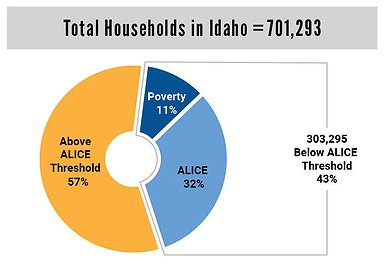ALICE report: wage growth outpaced by inflation
The newest ALICE report shows wage growth was no match for inflation after a decade of falling behind. ALICE is an acronym for Asset Limited, Income Constrained, Employed, and represents the growing number of families who struggle with meeting housing, childcare, food, transportation, health care and technology needs.
Stephanie Hoopes, the United For ALICE National Director, said the data shows persistent and widespread financial hardship across the board.
From 2010 to 2022, people aged 65 and over made up the fastest-growing age group in Idaho — and the group with the largest increase (76%) in the number of households struggling to make ends meet.
“Current policy has not been enough to break down the barriers that trap ALICE households in financial hardship, from the loss of pandemic supports to inadequate community supports such as broadband internet," Hoopes said.
Though wages for the lowest paid jobs have risen across the country at the fastest rate in four decades, the number of households struggling to get by in Idaho grew by more than 8,600 from 2021 to 2022.
Because of this, 303,295 households or 43% were living paycheck to paycheck in 2022, according to a new Update from United Way of North Idaho and its research partner United For ALICE.
For a family of four with an infant and a preschooler, the basic costs to live and work in Idaho, excluding tax credits, rose from $80,112 in 2021 to $83,700 a year later. In 2022, there was also a loss of up to $15,000 in federal child tax credits and stimulus payments that the same family had access to in 2021.
UNITED for ALICE grew out of a project in New Jersey about 10 years ago with Rutgers University. Now there are collaborative local research teams determining what the real costs in the communities are as part of Idaho’s 2024 report.
In North Idaho, United Way of North Idaho executive director Mark said the numbers vary by county, but the overall numbers are going up.
"In Kootenai County, the percentage of ALICE (population) went down a little bit, but the number of people increased because so many more people are here," Tucker said. "In Shoshone County, the percentage increased, and the numbers increased."
The findings in this one-year period are consistent with a more than decade-long trend: Since the end of the Great Recession, despite some ups and downs, the number of ALICE households in Idaho has been steadily growing.
From 2010 to 2022, the total number of households rose by 21%, households in poverty decreased by 8% — and the number of ALICE households grew by a substantial 48%.
"A lot of young families experience troubles with childcare in addition to housing," Tucker said.
To try and combat some of these issues, the local United Way will reopen its childcare scholarship program in August at uw.northidaho.org.
2024 ALICE report data:
Households, poverty households, ALICE households, above ALICE Households, below ALICE Threshold
Benewah, 3826, 631, 1405, 1790, 53.2%
Boundary, 4710, 850, 1491, 2369, 49.7%
Bonner, 19228, 2382, 6107, 10739, 44.1%
Kootenai, 71309, 7264, 20582, 43463, 39.0%
Shoshone, 5478, 928, 2343, 2207, 59.7%
Total Region One, 104551, 12055, 31928, 60568, 42.1%
Source: 2022 data from UnitedForALICE website and county reports.
For more information, visit www.uwnorthidaho.org or call 280-667-8112.



